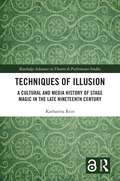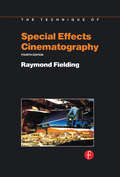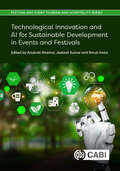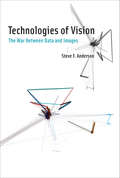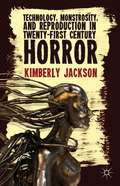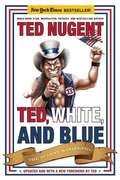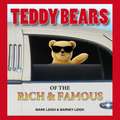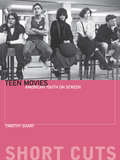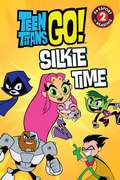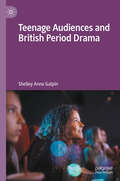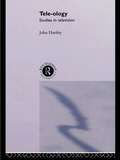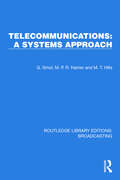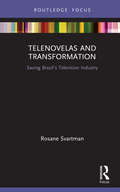- Table View
- List View
Techniques of Acting (Routledge Revivals)
by Ronald HaymanOriginally published in 1969, this was the first book of its kind: an attempt to describe the different approaches that the actor needs to make to different media – theatre, film and television – and to show how the art of acting, which never stops evolving had entered into a new phase of growth in the sixties. Ronald Hayman examines questions which are basic, but had often been ignored: What exactly goes on inside the actor’s mind while (s)he is preparing a part? How much do actors vary in their approach? Where does personality stop and technique begin? This wide-ranging study of the actor at work is based partly on what outstanding actors have said about their methods but chiefly on close analysis of actual performances in plays, films and on television. Laurence Olivier, Helene Weigel, Jeanne Moreau and many others are both examined in close-up and viewed in perspective against the giants of the past like Bernhardt and Salvini.
Techniques of Illusion: A Cultural and Media History of Stage Magic in the Late Nineteenth Century (Routledge Advances in Theatre & Performance Studies)
by Katharina ReinThis book explores stage conjuring during its “golden age,” from about 1860 to 1910. This study provides close readings highlighting four paradigmatic illusions of the time that stand in for different kinds of illusions typical of stage magic in the “golden age” and analyses them within their cultural and media-historical context: “Pepper’s Ghost,” the archetypical mirror illusion; “The Vanishing Lady,” staging a teleportation in a time of a dizzying acceleration of transport; “the levitation,” simulating weightlessness with the help of an extended steel machinery; and “The Second Sight,” a mind-reading illusion using up-to-date communication technologies. These close readings are completed by writings focusing on visual media and expanding the scope backwards and forwards in time, roughly to 1800 and to 2000. This exploration will be of great interest to students and scholars in theatre and performance studies.
Techniques of Special Effects of Cinematography (Library Of Communication Techniques)
by Raymond FieldingFirst published in 1985. Exactly 20 years have passed since the first edition of this text appeared, in 1965. During this period, the author has gathered feedback from professional film-making circles. This fourth revision introduces new information in nearly all chapters. 130 new illustrations have been added, many of them illustrating feature films which are currently in release. The bibliography has also been enlarged considerably. The contributions of the visual-effects cinematographer have always been valued highly within the theatrical motion-picture industry. Because of their work, film producers have been able to endow their pictures with considerable 'production value' which the budget could not otherwise sustain.
Techno-Orientalism
by Jinny Huh Catherine Fung Abigail De Kosnik Seo-Young Chu Dylan Yeats Kathryn Allan Julie Ha Tran Aimee Bahng Jason Crum Tzarina T. Prater Douglas S. Ishii Greta A. Niu Kenneth Hough Betsy Huang Se Young Kim Warren Liu Victor Bascara David S. Roh Steve Choe Charles ParkWhat will the future look like? To judge from many speculative fiction films and books, from Blade Runner to Cloud Atlas, the future will be full of cities that resemble Tokyo, Hong Kong, and Shanghai, and it will be populated mainly by cold, unfeeling citizens who act like robots. Techno-Orientalism investigates the phenomenon of imagining Asia and Asians in hypo- or hyper-technological terms in literary, cinematic, and new media representations, while critically examining the stereotype of Asians as both technologically advanced and intellectually primitive, in dire need of Western consciousness-raising. The collection's fourteen original essays trace the discourse of techno-orientalism across a wide array of media, from radio serials to cyberpunk novels, from Sax Rohmer's Dr. Fu Manchu to Firefly. Applying a variety of theoretical, historical, and interpretive approaches, the contributors consider techno-orientalism a truly global phenomenon. In part, they tackle the key question of how these stereotypes serve to both express and assuage Western anxieties about Asia's growing cultural influence and economic dominance. Yet the book also examines artists who have appropriated techno-orientalist tropes in order to critique racist and imperialist attitudes. Techno-Orientalism is the first collection to define and critically analyze a phenomenon that pervades both science fiction and real-world news coverage of Asia. With essays on subjects ranging from wartime rhetoric of race and technology to science fiction by contemporary Asian American writers to the cultural implications of Korean gamers, this volume offers innovative perspectives and broadens conventional discussions in Asian American Cultural studies.
Technological Innovation and AI for Sustainable Development in Events and Festivals (Festival and Event Tourism and Hospitality Series)
by Anukrati Sharma Jeetesh Kumar Shruti AroraFrom sustainable event planning to the influence of VR, AI, and mobile applications on tourist behaviour, this book explores the dynamic landscape where innovation meets tradition. It studies the intersection of green technologies, sustainable infrastructure, and the delicate balance between cutting-edge tools and the intrinsic emotional aspects of human engagement. Aligned with the United Nations' 17 Sustainable Development Goals, the book highlights AI's potential to drive meaningful contributions to a sustainable future. It anticipates the imminent transformation of festivals and events through technological innovation and AI implementation. It will allow the reader to gain insights into how automation streamlines logistics, optimizes marketing efforts, and enhances the overall attendee experience. The book offers readers: · A cutting-edge exploration of the transformative impact of technologies and artificial intelligence on the events and tourism industries. · Oversight of how new technology can align with the United Nations' 17 Sustainable Development Goals - readers can anticipate insights into how AI can contribute meaningfully to understanding and addressing pressing global challenges. · Practical insights for stakeholders including actionable insights that go beyond theory. It will be an essential reference for academic researchers and practitioners within events and tourism management.
Technologies of Gender: Essays On Theory, Film, And Fiction
by Teresa de de Lauretis"Technologies of Gender builds a bridge between the fashionable orthodoxies of academic theory (Lacan, Foucault, Derrida, et al.) and the frequently-marginalized contributions of feminist theory.... In sum, de Lauretis has written a book that should be required reading for every feminist in need of theoretical ammunition--and for every theorist in need of feminist enlightenment." --B. Ruby Rich"... sets philosophical ideas humming.... she has much to say." --Cineaste"I can think of no other work that pushes the debate on the female subject forward with such passion and intellectual rigor." --SubStanceThis book addresses the question of gender in poststructuralist theoretical discourse, postmodern fiction, and women's cinema. It examines the construction of gender both as representation and as self-representation in relation to several kinds of texts and argues that feminism is producing a radical rewriting, as well as a rereading, of the dominant forms of Western culture.
Technologies of Gender: Essays on Theory, Film, and Fiction
by Teresa De LauretisWhile all the essays in the volume imply the feminist perspective articulated in "Alice Doesn't", a development may be seen to have taken place (especially in essays 1, 7, and 8) with regard to the understanding of feminism as a radical rewriting, as well as a rereading, of the dominant forms of Western culture; a rewriting which effectively inscribes the presence of a different, and gendered, social subject. But even so, what these essays propose and argue for is a continued testing of the boundaries, an essaying of the no-man's land inhabited by "Alice," rather than a fully constructed view from "elsewhere."
Technologies of Vision: The War Between Data and Images (The\mit Press Ser.)
by Steve F AndersonAn investigation of the computational turn in visual culture, centered on the entangled politics and pleasures of data and images.If the twentieth century was tyrannized by images, then the twenty-first is ruled by data. In Technologies of Vision, Steve Anderson argues that visual culture and the methods developed to study it have much to teach us about today's digital culture; but first we must examine the historically entangled relationship between data and images. Anderson starts from the supposition that there is no great divide separating pre- and post-digital culture. Rather than creating an insular field of new and inaccessible discourse, he argues, it is more productive to imagine that studying “the digital” is coextensive with critical models—especially the politics of seeing and knowing—developed for understanding “the visual.”Anderson's investigation takes on an eclectic array of examples ranging from virtual reality, culture analytics, and software art to technologies for computer vision, face recognition, and photogrammetry. Mixing media archaeology with software studies, Anderson mines the history of technology for insight into both the politics of data and the pleasures of algorithms. He proposes a taxonomy of modes that describe the functional relationship between data and images in the domains of space, surveillance and data visualization. At stake in all three are tensions between the totalizing logic of data and the unruly chaos of images.
Technology and Film Scholarship: Experience, Study, Theory (Film Theory in Media History)
by André GaudreaultThis volume brings together a wide range of research on the ways in which technological innovations have established new and changing conditions for the experience, study and theorization of film. Drawn from the IMPACT film conference (The Impact of Technological Innovations on the Historiography and Theory of Cinema) held in Montreal in 2011, the book includes contributions from such leading figures in the field as Tom Gunning, Charles Musser, Jan Olsson and Vinzenz Hediger.
Technology, Monstrosity, and Reproduction in Twenty-First Century Horror
by Kimberly JacksonThrough a wide spectrum of horror sub-genres, this book examines how the current state of horror reflects the anxieties in Western culture. Horror films bring them to a mass audience and offer new figures for the nameless faceless 'antagonist' that plagues us and provides material with which to build a different understanding of ourselves.
Ted, White and Blue: The Nugent Manifesto
by Ted NugentAnother hell-raising book by the famous rocker, where he comments on the state of USA and how to fix many of our problems
Teddy Bears of the Rich and Famous
by Mark LeighA fantastic gift book for all ages which imagines what the teddy bears of the rich and famous would look like.Even the most tyrannical of despots or the most scholarly of geniuses probably had a 'Mister Cuddles' or 'Big Ted' at some point in their childhood. As the book's title suggests, this is a collection of bears that could have belonged to the rich and famous. Whether it's politicians, heads of state, artists, spiritual leaders, inventors, revolutionaries, entertainers or entrepreneurs, the teddy bears reflect the personalities/traits of their owners.
Teen Movies
by Timothy SharyTeen Movies: American Youth on Screen is a detailed look at the depiction of teens on film and its impact throughout film's history. Timothy Shary looks at the development of the teen movie -- the rebellion, the romance, the sex and the horror -- up to contemporary portrayals of ever-changing youth. Films studied include Rebel Without a Cause (1955), Splendor in the Grass (1961), Carrie (1976), The Breakfast Club (1985), and American Pie (1999).
Teen Movies: A Century of American Youth (Short Cuts)
by Timothy SharyCinema has always engaged with the experiences, hopes, fears, and anxieties of—and about—adolescents, teenagers, and young people. This book is a comprehensive and accessible history of the depiction of teenagers in American film, from the silent era to the twenty-first century.Timothy Shary explores the development of teenage roles across eras and industrial cycles, such as the juvenile delinquent pictures of the 1950s, the beach movies of the 1960s, the horror films of the 1980s, and the fantasy epics of the 2000s. He considers the varied genres of the teen movie—horror and melodrama, romance and adventure, fantasy and science fiction—and its shifting themes and tropes around sex and gender, childhood and adulthood, rebellion and social order, crime and consumer culture. Teen Movies features analyses of films such as Rebel Without a Cause (1955), Splendor in the Grass (1961), Carrie (1976), The Breakfast Club (1985), American Pie (1999), and the Twilight series (2008–2012).This second edition is updated throughout and features a new chapter examining Millennials and Generation Z on screen, with discussions of many contemporary topics, including queer youth in movies like Moonlight (2016), abortion in films such as Never Rarely Sometimes Always (2020), and the flourishing of a “tween” cinema as seen in Are You There God? It’s Me, Margaret. (2023).
Teen Movies: American Youth on Screen (Short Cuts)
by Timothy Shary Rob McInnesTeen Movies: American Youth on Screen is a detailed look at the depiction of teens on film and its impact throughout film's history. Timothy Shary looks at the development of the teen movie – the rebellion, the romance, the sex and the horror – up to contemporary portrayals of ever-changing youth. Films studied include Rebel Without a Cause (1955), Splendor in the Grass (1961), Carrie (1976), The Breakfast Club (1985), and American Pie (1999).
Teen TV: Representations, Reading and Production Modes of Contemporary Youth Series
by Florian Krauß Moritz StockTeen TV is booming. Current youth series on streaming platforms are a clear indication of this, but have so far received little attention in German-language media studies. This anthology provides a fundamental introduction to serial teen TV and takes a look at central case studies, from 13 Reasons Why to DRUCK, the German adaptation of the Norwegian transmedia youth drama SKAM. In addition to the content and aesthetics of serial teen narratives, it looks at their reception and production contexts.
Teen TV: Repräsentationen, Lesarten und Produktionsweisen aktueller Jugendserien
by Florian Krauß Moritz StockDas Teen TV boomt. Aktuelle Jugendserien auf Streaming-Plattformen sind dafür ein klares Indiz, haben in der deutschsprachigen Medienwissenschaft bislang aber kaum Beachtung gefunden. Dieser Sammelband führt grundlegend in das serielle Teen TV ein und nimmt zentrale Fallbeispiele in den Blick, von 13 Reasons Why bis zu DRUCK, der deutschen Adaption des norwegischen Transmedia-Jugenddramas SKAM. Neben den Inhalten und der Ästhetik der seriellen Jugendnarrationen geht es um ihre Rezeption und um Produktionskontexte.
Teen Titans Go! (TM): Silkie Time
by Magnolia BelleLearn about the Teen Titans' mascot and everybody's favorite worm, Silkie! Passport to Reading Level 2 TM & © DC Comics. (s17)
Teenage Audiences and British Period Drama
by Shelley Anne GalpinThis book provides an engaging insight into the responses of teenage audiences to British period drama, presenting original data collected from young people across England. Situated in relation to debates regarding the heritage film and young people’s consumption of the media, Teenage Audiences and British Period Drama challenges the often homogenous characterisation of teenagers by demonstrating the range of responses this genre inspires in young viewers. Arguing for the period drama’s underestimated relevance to younger audiences, the book details the varied ways that young people use film and television drama to make sense of the world and their place in it, and highlights the under-researched significance of collective viewing in influencing viewer response. Analysis demonstrates the key role that values play in influencing judgements amongst youth audiences, the importance of perceived historical accuracy and the potential for screen texts to inspire a deeper relationship with the past.
Teenage Revolution
by Alan DaviesWhen Alan Davies was growing up he seemed to drive his family mad. 'What are we going to do with you?' they would ask - as if he might know the answer.Perhaps it was because he came of age in the 1980s. That decade of big hair, greed, camp music, mass unemployment, social unrest and truly shameful trousers was confusing for teenagers. There was a lot to believe in - so much to stand for, or stand against - and Alan decided to join anything with the word 'anti' in it. He was looking for heroes to guide him (relatively) unscathed into adulthood.From his chronic kleptomania to the moving search for his mother's grave years after she died; from his obsession with joining (going so far as to become a member of Chickens Lib) to his first forays into making people laugh (not always intentionally); Teenage Revolution is a touching and funny return to the formative years that make us all.
Teenagers From Outer Space
by Mike PondsmithSo How Does a Six-Armed Green-Skinned Guy from Arcturus Get a Date on a Saturday Night? Yo, dude! Aliens from Beyond the Stars have invaded our planet! They're enrolling their kids in our schools, shopping in our shopping malls, and hanging out in our fast food joints! High school is never going to be the same again. Six-armed green-skinned guys from Arcturus are gonna date your kid sister! Silicon-based lifeforms are gonna poke their school lunch and wonder what it's supposed to be! On second thought, maybe high school won't be so different after all. What Is This Thing? Teenagers from Outer Space is a roleplaying game set on an Earth where fun-loving space aliens go to our high schools and party with the Earth kids. In the game you play the part of a teenager-alien or human-and have adventures fighting mutant monstrosities, saving the world from ravening rabbits from the X dimension, and getting your homework in on time. You're not a gamer? No sweat, dude. Teenagers is a giggle. You'll have fun reading it, even if you never play. (Honest. Hey, trust us on this one, okay?) And if you decide to play, it'll be a snap. Unlike other roleplaying games, Teenagers doesn't have encyclopedia-long rules that you have to study like a textbook before you can play. You can learn to play this thing in minutes. Seconds, even. . . . Well, okay, maybe not seconds. And if you are a gamer-hey, butchering orcs is swell for a while, but isn't it time for a change of pace? Dragons are dangerous and dungeons are deadly, but there's nothing quite as awesome, quite as fearful, quite as horrifying as an order to report to...the principal's office!
Tele-ology: Studies in Television
by John HartleyTeleology brings together John Hartley's work on television. The book draws on current critical theory in cultural studies to develop a wide-ranging and thought-provoking view of television broadcasting in Britain, Australia and the USA.Neighbours, Hancock's Half Hour, Dallas, Monty Python, Miami Vice, Beverly Hillbillies and Bonanza are among the examples of TV art that are discussed in Hartley's exploration of cultural politics. He takes in TV truth and propaganda; populism in the news; mythologies of the audience; TV drama as a `photopoetic' genre in the tradition of Shakespeare; Kylie Minogue, Madonna and gardening shows.
Telecommunications in Developing Countries: The Challenge from Brazil (Routledge Library Editions: Broadcasting #34)
by Michael HobdayTelecommunications in Developing Countries (1990) stresses the importance of modern, micro electronics-based telecommunications for developing economies in providing a basic communications infrastructure for economic and industrial development and the springboard for new information technology activities. Although progress in telecommunications has so far been concentrated in the most advanced regions of the world, some developing countries can bypass older, less efficient forms of telecommunications and go straight to microelectronic technology. This book is the first to examine the challenges and difficulties facing developing countries in this field. extending existing theories of technology transfer and diffusion, Michael Hobday offers an explanation of the forces for change in the telecommunications industry. He then examines Brazil's experience in telecommunications, from developing the technology and building up a modern infrastructure to controlling multinational suppliers of equipment. Dr Hobday explains why Brazil's efforts in this area have succeeded, and offers lessons for other developing countries.
Telecommunications: A Systems Approach (Routledge Library Editions: Broadcasting #33)
by G. Smol M.P.R. Hamer M.T. HillsTelecommunications: A Systems Approach (1976) uses two extended case studies, of public telephone and television systems, in order to introduce the basic ideas of telecommunication systems. It describes the application of a number of techniques within the context of practical telecommunications systems, and takes into account the needs of the users of these systems and the economic constraints which affect the choice of techniques and the overall system structure.
Telenovelas and Transformation: Saving Brazil’s Television Industry (Routledge Advances in Transmedia Studies)
by Rosane SvartmanThis book investigates how telenovelas may be the key to the future of Brazilian television and how this content can survive in an interconnected media landscape. Recognised telenovela writer and scholar Rosane Svartman considers the particular characteristics of the telenovela format – number of episodes, melodrama influence, and influence of the audience on future writing – to explore how these can be preserved on multimedia platforms, and the challenges this change may present. Svartman further charts the transformations of the telenovela throughout its history and its major influences and unveils the main storytelling elements and writing processes. Chapters examine the business model of Brazilian corporate television within the current context of hypermedia and analyse how this relationship evolves as it is influenced by the new interactive tools and technologies that amplify the audience’s power. Merging empirical practices and theory, this book will be of great interest to scholars and students of transmedia storytelling, television studies, and Latin American media, as well as professionals working in these areas.

